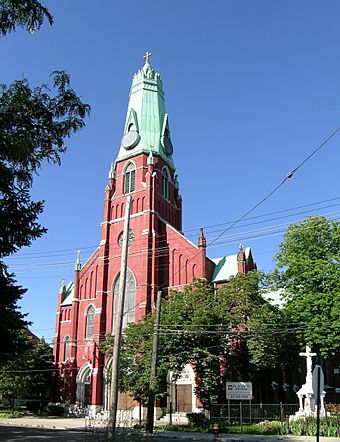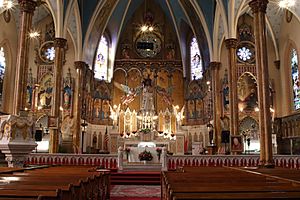St. Albertus Roman Catholic Church facts for kids
|
St. Albertus Roman Catholic Church
|
|

St. Albertus façade
|
|
| Location | 4231 St. Aubin Street Detroit, Michigan |
|---|---|
| Built | 1885 |
| Architect | Henry Engelbert |
| Architectural style | Polish Cathedral style, Gothic Revival |
| NRHP reference No. | 78001522 |
Quick facts for kids Significant dates |
|
| Added to NRHP | January 18, 1978 |
St. Albertus Roman Catholic Church is a historic church located in the Forest Park neighborhood of Detroit, Michigan. It was recognized as a Michigan State Historic Site in 1974. Later, in 1978, it was added to the National Register of Historic Places, which lists important historical places across the United States.
Contents
History of St. Albertus Church
Polish Immigrants Settle in Detroit
In the 1800s, many Polish people moved to Detroit, seeking new opportunities. By the mid-1850s, a large number of Polish families lived in the city. Most of these immigrants came from parts of Poland that were controlled by Prussia. They often settled near German-speaking areas of Detroit.
After the American Civil War, more Polish immigrants, including those from a region called Kashubia, joined them. Many Polish and Kashubian newcomers first attended St. Joseph's, which was a German-speaking church. However, the Polish churchgoers wanted a church where they could worship in their own language.
Founding a Polish Parish
In 1870, with help from Father Simon Wieczorek, the Polish community began to create their own church. They formed a group called the St. Stanislaus Kostka Society. With the approval of Bishop Caspar Borgess, they started collecting money to build a church.
In 1871, the St. Albertus Parish was officially formed, with about 300 Polish families. That same year, the parish bought land on St. Aubin Avenue. They hired architect John Wiesenhoffèr, and construction of a wooden church began in 1872.
The church was named after St. Wojciech, a Polish saint. Early leaders used the Latin name Adalbertus, which is St. Albertus or St. Albert in English. Because of the new church, many Polish families moved to the nearby area. This led to the creation of Detroit's first Polish neighborhood, known as "Poletown".
Building a Larger Church
St. Albertus had several pastors over the years. In 1882, Father Dominic Hippolytus Kolasinski became the pastor. He was very inspiring and encouraged his parishioners to build a much larger church.
The parish hired architect Henry Engelbert to design a church big enough for 2,500 people. The Spitzely Brothers of Detroit built it for $61,000. Construction started in 1883, and the church was officially opened on July 4, 1885. At that time, St. Albertus was the largest Catholic church in Michigan. It was also the first church in Detroit to have steam heating and electric lights.
Challenges and New Parishes
Father Kolasinski was a very strong leader, but he also caused some disagreements within the church community. In November 1885, the parish became divided, and he was asked to leave his position. Father Kolasinski tried to stay, but eventually left Detroit for a different church in the Dakota Territory.
However, many of his followers remained separate from the other St. Albertus members. They even started their own church school. When John Samuel Foley became Bishop of Detroit in 1888, Father Kolasinski returned to the city. He then started a new church called the Sweetest Heart of Mary, which was outside the usual church authority.
Even though St. Albertus faced challenges, it is known as the "mother church" for over 30 Polish Catholic churches in the area. These include Sweetest Heart of Mary, St. Josaphat, and St. Stanislaus.
Later Years and Preservation
A rectory building, where the priests live, was built next to the church in 1891. A school was built behind the church in 1917, replacing older school buildings. In 1990, the parish was closed as part of a reorganization by the local church leadership.
In 1991, a group of church members formed The Polish American Historic Site Association (PAHSA). Their goal was to take care of and protect St. Albertus. Today, the church still holds monthly Masses in Polish, English, and Latin. It is also open for tours and weddings.
Rev. John A. Lemke, born in Detroit in 1866, was the first Roman Catholic priest of Polish background to be ordained in the United States. He was baptized at St. Mary's Church and attended St. Albertus for his early education.
Description of St. Albertus Church
St. Albertus is a large brick building. It is about 200 feet long and 70 feet wide. The church originally had a tall spire that reached 280 feet high. However, the spire was shortened after a strong windstorm damaged it in 1913.
While the outside of St. Albertus is made of plain brick, the inside is very decorative and looks like something from the Middle Ages. The altars, the baptismal font (where baptisms happen), and the lower wall coverings are made of patterned terra-cotta. The ceiling is beautifully painted with detailed designs. Inside the church, there are 63 pieces of painted plaster sculptures. The windows are decorated with colorful stained glass in a Medieval style.
See also
 In Spanish: Iglesia de San Alberto (Detroit) para niños
In Spanish: Iglesia de San Alberto (Detroit) para niños
- History of the Polish Americans in Metro Detroit
- Archdiocese of Detroit


